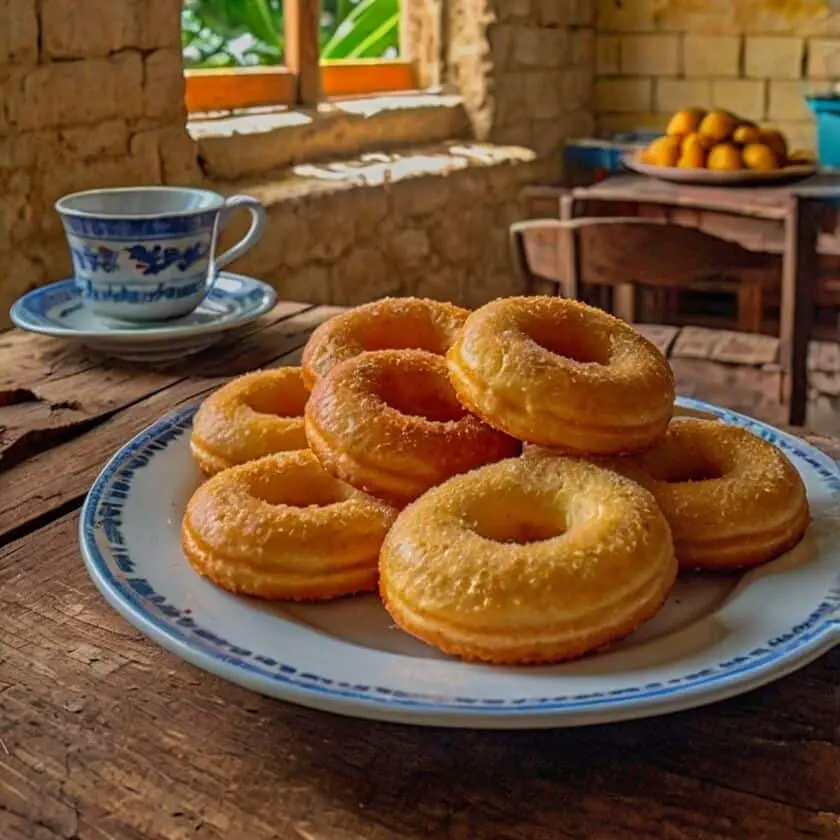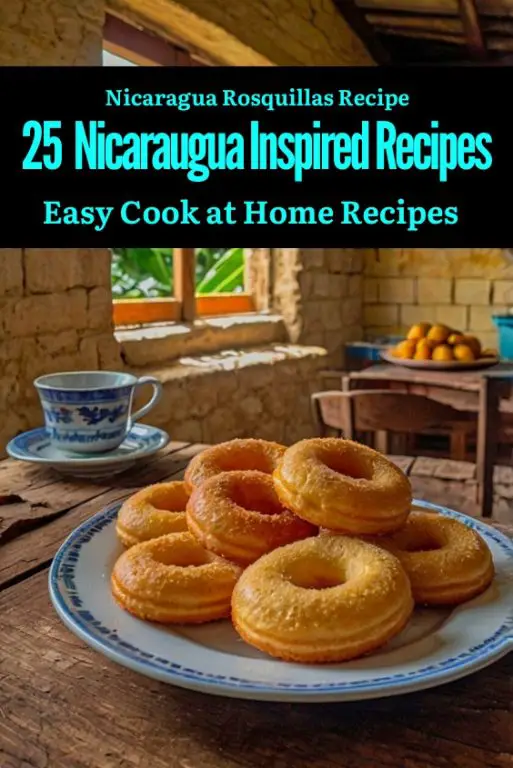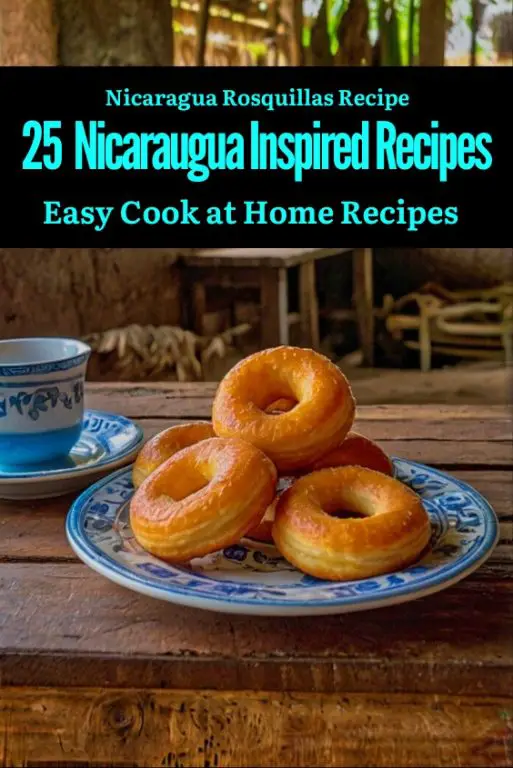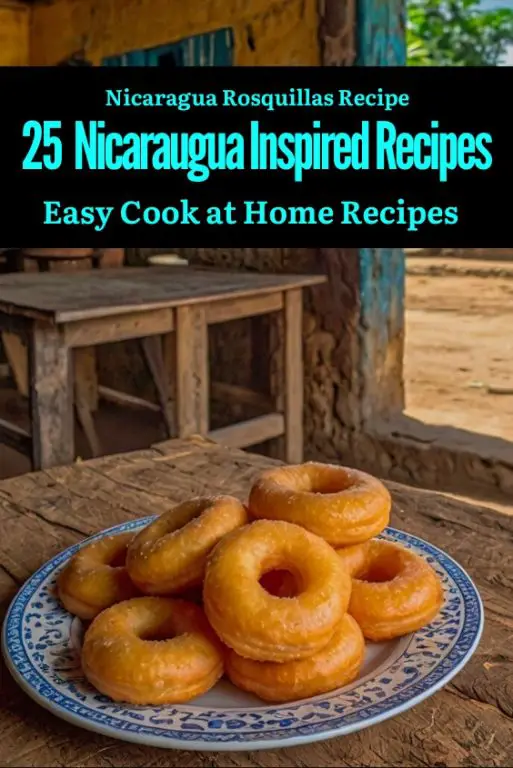Today I am sharing the Nicaraguan Rosquillas recipe with you. Most people are intrigued with the range of world cuisines and so am I. Among them is Nicaraguan Rosquillas, a corn cookie out of Central American tradition. As I discovered the history and variations of this scrumptious treat, Rosquillas de Maiz are more than a snack – they’re a key part of Nicaraguan culture.
The secret to Nicaraguan Rosquillas is in the easy to follow recipe. You usually begin with a base of finely ground cornmeal (masa harina), and that forms the center of the cookie. Several of the recipes I discovered called for using farmer’s cheese (queso seco), which is a wonderful taste that goes well with the corn. You can use any fat – lard, butter, or a mixture – for getting the crunch and filling texture. Using what you have on hand makes it less difficult on everybody to follow the recipe.
The best recipes I’ve ever made allow for creativity, and Rosquillas are no exception. One fascinating aspect is the sugar content; You are able to change it however you would like. Some versions have very little sugar so the corn taste comes through, while other versions have just enough sweetness just for the average sweet tooth. During my experiments, I learned to taste as you go. You’re the one who will actually enjoy the cookies, so customize them to your taste.
An additional fascinating fact about Nicaraguan Rosquillas is the drying process. They bake or are fried at a mild temperature to get that first golden brown then get a second, low temperature bake for crunch. This step is needed, as it transforms them out of a basic cookie into a delightful companion for your afternoon coffee or a sugary dessert soup. They truly shine if you enjoy them alongside your favorite warm beverage.
If you wish to make this delicious treat, take note of the techniques in the recipe below. You can toast your cornmeal in a dry pan before using it. The toasted corn smell is so good and gives the cookies a bit more depth. And in case you live in a situation where finding the perfect cheese for the recipe is a pain, worry not: We have got you covered: Any dried, grated cheese will do. It is about adapting the recipe to your tastes and ingredients.
Ingredients For the Nicaraguan Rosquillas Recipe
Cornmeal
All-purpose Flour
Sugar
Melted Unsalted Butter
Large Eggs
Baking Powder
Salt
Vanilla Extract
Vegetable Oil
Cooking Instructions For the Nicaraguan Rosquillas Recipe
- In a large mixing bowl, combine the cornmeal, all-purpose flour, sugar, baking powder, and salt.
Mix well to ensure the dry ingredients are evenly incorporated. Use a whisk or spoon to thoroughly combine the dry ingredients. Make sure there are no lumps in the mixture. - Stir until all the ingredients are well combined and a sticky dough is formed. Crack the eggs into a separate bowl before adding them to the mixture. Stir in the vanilla extract for added flavor.
- Mix until the dough is smooth and there are no visible streaks of dry ingredients. nsure the mixture is evenly moistened.
- Cover the dough and let it rest for about 30 minutes at room temperature. This allows the dough to hydrate and ensures a better texture when frying. Use plastic wrap or a clean kitchen towel to cover the dough.
- Heat vegetable oil in a deep pot or frying pan over medium heat. The oil should be hot enough to fry the Rosquillas but not smoking. Add enough oil to ensure the Rosquillas can be fully submerged.
- Shape the dough into small rounds, approximately 1 inch in diameter. You can use your hands or a cookie scoop to portion the dough. Ensure the rounds are uniform in size for even cooking.
- Drop the completed grounds into the oil, when they bob to the top they are ready. Contiue untill all of the dough is used. Cover with confection powder for added sweetness.
10 Reasons I Love Nicaraguan Food
Nicaraguan food is a unique blend of indigenous traditions, Spanish influence, and a touch of Creole flair. It’s rich in history and flavor, making it a joy to explore. Here are 10 reasons why I love Nicaraguan food:
1. Gallo Pinto – The Staple of Every Meal
Gallo pinto, a simple combination of rice and beans, is served at almost every meal in Nicaragua. Its versatility is impressive; it can be enjoyed for breakfast with eggs and cheese or served as a side dish for lunch or dinner. The subtle flavor of fried beans mixed with perfectly cooked rice makes this dish a comforting and satisfying part of Nicaraguan cuisine.
2. Fresh and Local Ingredients
Nicaraguan cuisine is deeply connected to the country’s agricultural roots. Fresh fruits, vegetables, and meats are widely used, meaning most dishes are made from locally sourced, organic ingredients. This focus on fresh produce brings out the natural flavors of the food.
3. Corn-Based Dishes
Corn is a staple in Nicaraguan food, found in dishes like tortillas, nacatamales, and atol. Whether it’s the thick, handmade tortillas or the masa used in nacatamales, the richness of corn is evident in many traditional meals, providing a hearty base for various dishes.
4. Tasty Street Foods
Nicaraguan street food is diverse and delicious. From quesillo, a tortilla filled with soft cheese, onions, and cream, to vigorón, a mix of yucca, cabbage slaw, and pork rinds, the variety of quick, flavorful snacks is endless. Street food allows you to experience authentic Nicaraguan flavors on the go.
5. Balanced Use of Spices
Nicaraguan cuisine isn’t overly spicy, but it has just the right amount of seasoning. Spices like cumin, garlic, and annatto provide depth and warmth without overwhelming the dish. This balanced approach allows the natural flavors of the ingredients to shine through, making the food flavorful but not too intense.
6. Plantains Everywhere
Plantains are an essential part of Nicaraguan food, served in various forms like tostones (fried green plantains) or tajadas (fried ripe plantains). Their sweetness and starchiness complement savory dishes, adding a unique flavor and texture to meals.
7. Comforting Stews and Soups
Nicaraguan stews and soups, such as sopa de res (beef soup) and mondongo (tripe soup), are hearty and full of flavor. These dishes are often slow-cooked with vegetables and spices, resulting in rich, comforting broths that are perfect for any time of the year.
8. Nacatamales – A Celebration Food
Nacatamales are a Nicaraguan version of tamales, made with corn masa stuffed with pork or chicken, rice, potatoes, and spices, then wrapped in banana leaves and steamed. This dish is traditionally served during special occasions and holidays, making it a beloved comfort food. The combination of textures and flavors is unique, with the banana leaf adding a subtle earthy taste to the masa.
9. Delicious Desserts
Nicaraguan desserts, like tres leches cake and arroz con leche, are indulgent and satisfying. Tres leches cake, in particular, is a crowd favorite, with its sponge cake soaked in three kinds of milk, resulting in a rich, moist treat. The sweetness and creaminess of Nicaraguan desserts make them the perfect end to any meal.
10. A Blend of Cultures
Nicaraguan food is a beautiful mix of indigenous, Spanish, and Creole influences, which creates a rich culinary tapestry. From the indigenous use of corn to the Spanish introduction of rice and pork, the fusion of flavors and techniques makes Nicaraguan cuisine both diverse and uniquely flavorful.
Nicaraguan food is rich, comforting, and deeply connected to the country’s culture and history. Whether it’s the simplicity of gallo pinto or the complexity of nacatamales, each dish tells a story and offers a taste of Nicaragua’s diverse culinary heritage. From fresh, local ingredients to the balanced use of spices, these 10 reasons are just the beginning of why I love Nicaraguan food.
Eating Healthy in Nicaragua
Eating healthy in Nicaragua is a natural and accessible option, thanks to the abundance of fresh, locally sourced ingredients available throughout the country. Nicaraguan cuisine, while known for its hearty and comforting dishes, also offers many opportunities for nutritious and balanced meals. Fresh fruits and vegetables, such as avocados, tomatoes, and plantains, are staples in many traditional dishes and are readily available in local markets. Fruits like papaya, mango, and pineapples, rich in vitamins and antioxidants, are commonly eaten as snacks or incorporated into meals, providing essential nutrients for a healthy diet.
Another key aspect of healthy eating in Nicaragua is the use of lean proteins like chicken, fish, and beans. Gallo pinto, the national dish made from rice and beans, is not only delicious but also a great source of protein and fiber. Beans, in particular, are a major component of the Nicaraguan diet, offering plant-based protein and essential nutrients while being low in fat. Fresh fish, often caught from the country’s numerous lakes and coastal areas, is also widely consumed and is a lean protein rich in omega-3 fatty acids.
Whole grains, such as corn and rice, are also central to the Nicaraguan diet. Corn, in the form of tortillas or used in traditional dishes like nacatamales, provides fiber and essential carbohydrates without the need for processed additives. Nicaraguans often pair these grains with fresh vegetables and proteins to create balanced and nourishing meals. While some traditional foods, like fried plantains or pork, can be heavier, many Nicaraguan dishes focus on using fresh ingredients in simple, wholesome preparations.
Nicaragua’s emphasis on fresh, local produce, combined with its reliance on plant-based foods and lean proteins, makes it relatively easy to maintain a healthy diet. Even when indulging in traditional dishes like vigorón or baho, balance can be achieved by moderating portion sizes and pairing heavier foods with fresh salads or steamed vegetables. By focusing on fresh ingredients and mindful eating, it’s possible to enjoy the richness of Nicaraguan cuisine while still maintaining a healthy lifestyle.
FAQ For the Nicaraguan Rosquillas Recipe
Q: What are the main ingredients in a Nicaraguan Rosquillas recipe?
A: The Nicaraguan Rosquillas recipe primarily features corn flour, which is essential for achieving the unique texture and flavour of these traditional treats. Other key ingredients include sugar, salt, and baking powder, which help the rosquillas rise and develop a light and airy consistency. The recipe often incorporates anise seeds for a fragrant aroma and flavour, making these cookies distinctive. Additionally, some variations might use eggs or milk to enhance the richness and moisture of the dough.
Q: How are Nicaraguan Rosquillas traditionally prepared?
A: To prepare the Nicaraguan Rosquillas recipe, the corn flour is mixed with sugar, salt, baking powder, and anise seeds. After combining the dry ingredients, a liquid, such as water or milk, is gradually added to form a dough. The dough is then shaped into rings, either by hand or using a mould, and placed on a baking sheet. They are baked until golden brown, resulting in a deliciously crunchy texture on the outside and a soft, tender interior.
Q: What makes Nicaraguan Rosquillas a traditional snack in Nicaragua?
A: The Nicaraguan Rosquillas recipe is deeply rooted in Nicaraguan culture, often enjoyed during festive occasions and family gatherings. These treats are frequently served alongside coffee or hot chocolate, making them a popular choice for breakfast or as an afternoon snack. Their historical significance lies in their use of corn flour, a staple ingredient in Nicaraguan cuisine, reflecting the agricultural practices of the region. Additionally, the tradition of making rosquillas has been passed down through generations, connecting families to their culinary heritage.
Q: Can Nicaraguan Rosquillas be made gluten-free?
A: Yes, the Nicaraguan Rosquillas recipe can be adapted to be gluten-free by substituting traditional corn flour with gluten-free alternatives, such as rice flour or a gluten-free all-purpose flour blend. It is important to ensure that the flour used is finely ground to achieve the desired texture. Additionally, the other ingredients, such as baking powder and sugar, should be checked for gluten-free certification. With these modifications, you can enjoy the delightful flavours of rosquillas while accommodating gluten sensitivities.
Q: What are some common variations of the Nicaraguan Rosquillas recipe?
A: There are several variations of the Nicaraguan Rosquillas recipe that incorporate different ingredients or techniques. Some recipes might include shredded coconut or chocolate chips for added flavour and texture. Others may feature different spices, such as cinnamon, to give the cookies a warm and aromatic twist. Additionally, some variations might be fried instead of baked, resulting in a different texture and taste. These adaptations allow for creativity while still honouring the essence of this traditional Nicaraguan treat.

Nicaraguan Rosquillas Recipe
Ingredients
- 2 cups cornmeal
- 1 cup all-purpose flour
- 1 cup sugar
- 1/2 cup unsalted butter melted
- 2 large eggs
- 1 teaspoon baking powder
- 1/2 teaspoon salt
- 1/2 teaspoon vanilla extract
- Vegetable oil for frying
Equipment
- Mixing Bowl: A large bowl used to combine the ingredients and form the rosquillas dough.
- Baking Sheet: A flat sheet pan used to place the shaped rosquillas for baking in the oven.
- Oven: The cooking appliance used to bake the rosquillas until golden and crispy.
- Grater: A kitchen tool used to grate the cheese if required for the recipe.
- Measuring Cups and Spoons: Essential tools for accurately measuring the ingredients before adding them to the recipe.
Instructions
- Mix well to ensure the dry ingredients are evenly incorporated.
- Use a whisk or spoon to thoroughly combine the dry ingredients.
- Make sure there are no lumps in the mixture.
- Stir gently to avoid creating a cloud of flour.
- Ensure the bowl is large enough to accommodate all the ingredients.
- Pay attention to the measurement of each ingredient to maintain accuracy.
- Stir until all the ingredients are well combined and a sticky dough is formed.
- Gradually pour the melted butter into the mixture while stirring continuously.
- Crack the eggs into a separate bowl before adding them to the mixture.
- Stir in the vanilla extract for added flavor.
- Mix until the dough is smooth and there are no visible streaks of dry ingredients.
- Ensure the mixture is evenly moistened.
- This allows the dough to hydrate and ensures a better texture when frying.
- Use plastic wrap or a clean kitchen towel to cover the dough.
- Place the dough in a warm and draft-free area.
- The resting time allows the flavors to develop.
- Resting the dough helps it become more pliable and easier to work with.
- The dough will slightly rise during the resting period.
- The oil should be hot enough to fry the rosquillas but not smoking.
- Choose a pot or pan with high sides to prevent oil splatter.
- Add enough oil to ensure the rosquillas can be fully submerged.
- Use a deep-fry thermometer to monitor the oil temperature.
- The ideal frying temperature is around 350°F (175°C).
- Heating the oil slowly helps maintain a consistent temperature.
- You can use your hands or a cookie scoop to portion the dough.
- Ensure the rounds are uniform in size for even cooking.
- Dust your hands or the cookie scoop with flour to prevent sticking.
- Roll the dough between your palms to form smooth balls.
- Keep the rounds compact and evenly shaped.
- Work quickly to prevent the dough from drying out.
- Place the shaped rounds on a tray or plate for easy frying.





4 comments
I tried the Nicaragua Rosquillas Recipe, and these little cheese biscuits were the perfect snack. They had a nice crunchy texture, and the cheesy flavor was subtle but delicious.
I cant believe they didnt mention the secret ingredient for the Rosquillas recipe! And who needs 10 reasons to love Nicaraguan food when one bite is enough to fall in love? Crazy!
I cant believe they didnt mention the secret ingredient in the Nicaraguan Rosquillas recipe! Its essential for that authentic flavor. Do you think they left it out on purpose?
I cant believe they didnt mention the secret ingredient for the Nicaraguan Rosquillas recipe! Thats like leaving out the best part of the story. What a tease!